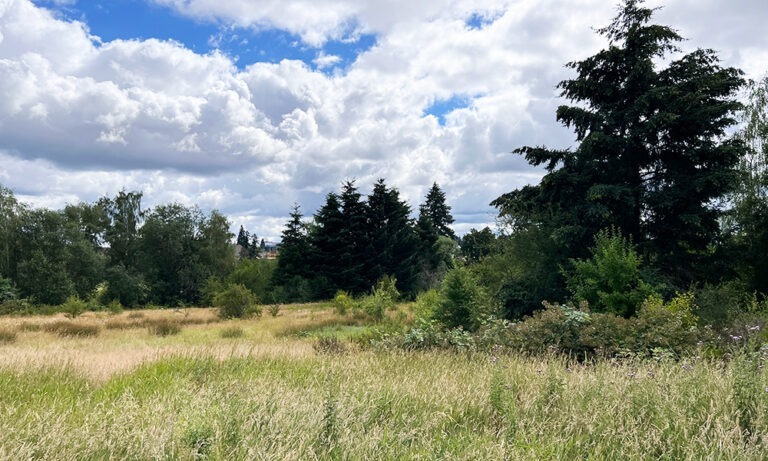Haley & Aldrich Geologist and former Sherwood City Councilor Jennifer Casler examines buried cowhides contaminated with chromium at the former Frontier Leather Tannery.
The Office of the Inspector General (OIG), the U.S. Environmental Protection Agency’s (EPA’s) internal watchdog, announced in January that it will audit the agency’s Brownfields Program to assess how closely it has aligned with Justice40 implementation goals. The EPA leads the federal government’s environmental justice (EJ) efforts. Its Brownfields Program is one of EPA’s most visible and longest-running EJ-focused programs. This program has seen a historic increase in funding due to the Infrastructure Investment and Jobs Act (IIJA) and the Inflation Reduction Act (IRA).
This audit highlights a question that many are asking, from applicants for federal funds to interested community stakeholders: How exactly is Justice40 being implemented, and how can it be measured?
The results of the EPA OIG’s audit will give us a picture of how the EPA assesses compliance with Justice40, the federal government’s signature EJ initiative. The audit’s findings can also inform grant application strategies for brownfields funding and potentially for other federal programs.
Justice40 and the Brownfields Program in context
The federal government announced Justice40 in 2021 in Executive Order 14008, “Tackling the Climate Crisis at Home and Abroad.” The “40” in Justice40 refers to the federal government’s goal to direct at least 40 percent of the benefits of targeted federal investments to disadvantaged communities — those impacted by EJ concerns because they are socioeconomically and environmentally overburdened by factors like pollution and poverty. The Climate and Economic Justice Screening Tool (CEJST) is a mapping application used for Justice40 analysis. It classifies disadvantaged communities based on specific metrics and associated thresholds. For example, CEJST identifies communities that are at or above the 90th percentile nationally for energy or housing costs as disadvantaged.
Justice40 applies to IIJA and IRA investments administered through 518 covered programs across 19 federal agencies that address issues related to climate resilience, environmental remediation, clean energy, affordable housing, and transportation. Applicants eligible for funding to address these issues may be wide-ranging, including utilities, municipalities, nonprofits, and many more. The Brownfields Program is among these Justice40-covered programs. The EPA defines a brownfield as a property where redevelopment or reuse may be complicated by the presence or potential presence of pollution or contamination. Since 1995, the Brownfields Program has awarded discretionary grants to support environmental assessment, cleanup, and reuse planning for these sites. The program received a $1.5 billion boost from the IIJA, which elevated Brownfields grants to historic levels starting in 2022.
Importantly, Justice40’s 40 percent goal focuses on benefits, not dollars. A key challenge stemming from this mandate is determining where the benefits of covered federal programs are being directed and how to measure their success to ensure that benefits are indeed reaching disadvantaged communities. Identifying and quantifying benefits is challenging, and each agency has its own guidance for measuring them. Benefits under the Brownfields Program may look very different from those under the Department of Transportation programs, for example. Mainly, each agency’s Justice40 guidance also informs its distinct requirements for funding and grant applications, which continue to evolve to support Justice40 objectives and are scored against related yet often vague Justice40 requirements.

An example of a potential brownfield site in eastern Washington.
The challenges of Justice40: the story of Sherwood, Oregon
CEJST offers one way to identify underserved communities. Other federal and state mapping applications, like EJScreen, as well as third-party mapping tools and census data, can also help.
However, ultimately, conducting an EJ analysis and making an EJ argument in the context of a funding application require detailed knowledge of your community.
As an example, when the City of Sherwood, Oregon, decided to pursue an EPA Brownfields Cleanup Grant to remediate a former tannery, they faced a challenge: Developing a successful application required Sherwood to identify vulnerable populations and articulate how remediating the 25-acre site could address EJ concerns.
In Sherwood’s case, city officials knew a disadvantaged community lived in one corner of a census tract adjacent to the former tannery. However, this disadvantage is not visible using the census tract-level data that powers CEJST: Census tracts cover a larger geographic area, which can render EJ burdens that exist at a more granular level invisible. To make the city’s case, Haley & Aldrich conducted research and helped Sherwood leverage additional mapping tools to present EJ data at the smaller census block group level, in addition to home values and data from the Sherwood School District. These alternative sources painted a picture of a need that available mapping tools could not. With these data, the city was able to more compellingly articulate how cleaning up the former tannery would directly benefit communities experiencing disproportionate socioeconomic and environmental burdens.
Sherwood’s application was ultimately successful: In May 2024, the EPA awarded the city $5 million to support the tannery cleanup — one of eight such awards nationally. The city’s experience, however, shows the challenge that many face: how to demonstrate compliance with Justice40 when the funding agencies themselves are less than clear about guidelines, and when the available tools don’t necessarily reflect local realities.
A lack of unity in federal agencies’ implementation of Justice40
Part of this challenge stems from the distinct ways each federal agency and its related programs interpret and implement Justice40, which they continue to gradually define internally and externally. These distinct interpretations stem from how each agency aligns EJ principles with its specific mission in juxtaposition with Justice40 policy priority areas like climate resilience, housing, and energy. These differences lead to diverging emphasis on the types of benefits to track and related forms of measuring progress.
The question of how to determine disadvantaged communities and quantify benefits related to priority areas has also evolved. Several tools, for example, exist to help identify communities that might be considered a priority for Justice40-related investments. The federal government has designated CEJST as the whole-of-government tool for this purpose; however, certain agencies may still ask applicants to leverage other agency-specific tools to convey a deeper nuance of community issues and disparities as part of a broader story about EJ impacts. Applicants themselves may consider leveraging these tools to communicate a clearer picture in their applications, as the City of Sherwood’s experience demonstrates.
For comparison, the table below contrasts three agencies’ Justice40 policy priority areas and preferred tools.
| | Department of Energy | Department of Transportation | Environmental Protection Agency |
| Policy focus | Clean energy access, efficiency, and affordability; reduction and remediation of legacy pollution | Affordable and clean transportation | Environmental health and reduction and remediation of legacy pollution |
| Tools | CEJST | CEJST, Equitable Transportation Community Explorer, Justice40 Rail Explorer | CEJST, EJ Screen |

Despite such distinctions, some implementation priorities cut across all agencies. Applicants can consider those must-haves when demonstrating proposed compliance with Justice40 in federal funding applications. Those priorities include:
- Meaningful engagement: Given that meaningful engagement is a major element of EJ, each agency places great emphasis on whether applicants demonstrate robust, two-way engagement and community involvement in project development and decision-making. An application may stand out when it includes examples of how the people impacted by a proposed project or initiative are involved in shaping decisions. Specificity is key: It’s the best practice to describe groups that will be engaged, goals, associated activities, and timelines.
- Benefit metrics: Benefits associated with projects can vary widely, and each agency places an emphasis on demonstrating measurable outcomes to align with claims. While agencies will be responsible for reporting out at a portfolio level, the burden of proof for quantifying and demonstrating the flow of those benefits applies to grant and funding applicants. This means applicants should be clear about who benefits from proposed activities, how they benefit, and the methodology for reporting on associated goals and indicators of success. For example, a project that claims it will create “x” number of quality jobs for a particular community should provide evidence for how job targets will be met, describe how jobs will be made available to the local project community (such as through workforce development), and explain how outcomes will be tracked.
Takeaways for funding applicants
The results of the EPA OIG’s audit will offer a clearer interpretation of how the agency defines, measures, and assesses benefits under Justice40. In the meantime, grant applicants can keep the following in mind:
- Context matters. Applicants know their communities best, and mapping platforms are just one tool. Making a strong EJ case requires understanding what these tools can tell you and what they can’t.
- Justice40 focuses on benefits, i.e., the positive impacts of programs, not the flow of dollars.
- EJ considerations are important in any context — even those without clearly defined disadvantaged communities — because all projects have benefits and impacts. Ensure that your application identifies potential impacts, explains your strategy for mitigating them, and accounts for benefits and who they will be directed to.
- It’s not a disqualifier if a project is not located in a disadvantaged community or an applicant does not qualify as a disadvantaged community.
- Your application should show that you’ve planned meaningful engagement in a concrete way across all aspects of project planning and implementation.
Taking these steps will ensure that however agencies calculate the overall impact of Justice40 compliance and contributions, your work will align with these requirements and advance environmental justice.
Published: 7/22/2024
Authors

Technical Expert

Senior Technical Specialist




